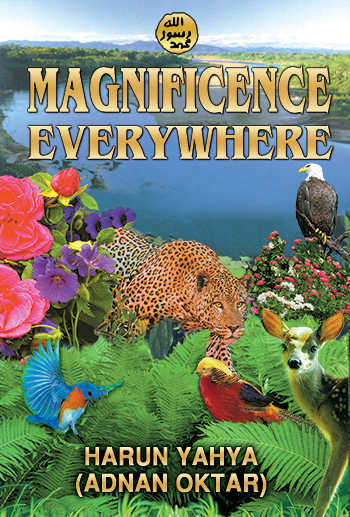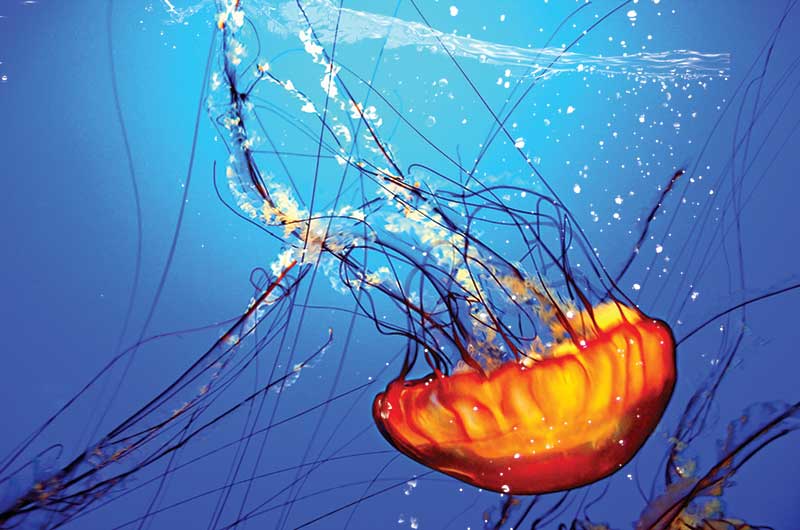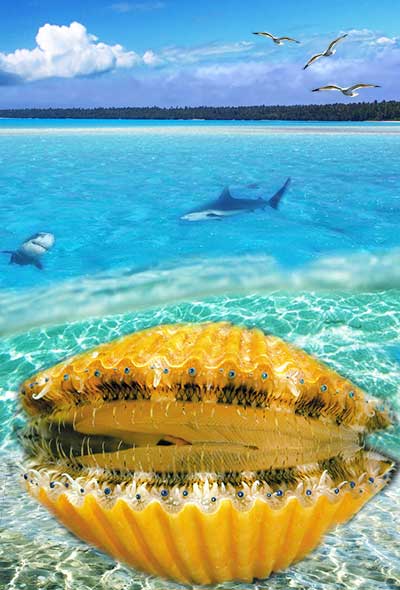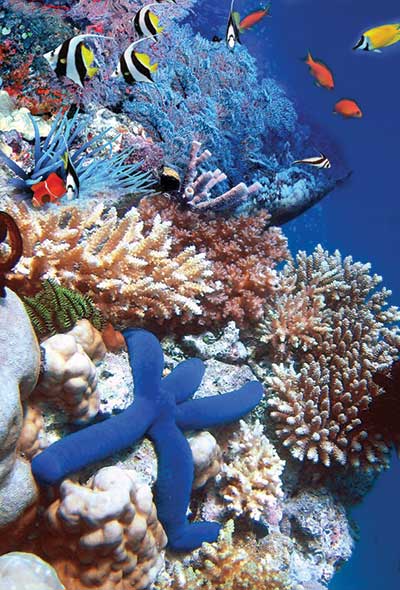Bigotry: The Dark Danger
Magnificence Everywhere

DOWNLOAD THE BOOK
CHAPTERS OF THE BOOK
- Magnificence Everywhere (1/15)
- Magnificence Everywhere (2/15)
- Magnificence Everywhere (3/15)
- Magnificence Everywhere (4/15)
- Magnificence Everywhere (5/15)
- Magnificence Everywhere (6/15)
- Magnificence Everywhere (7/15)
- Magnificence Everywhere (8/15)
- Magnificence Everywhere (9/15)
- Magnificence Everywhere (10/15)
- Magnificence Everywhere (11/15)
- Magnificence Everywhere (12/15)
- Magnificence Everywhere (13/15)
- Magnificence Everywhere (14/15)
- Magnificence Everywhere (15/15)
< <
8 / total: 15
Magnificence Everywhere (8/15)The Unknown Side of JellyfishEveryone knows of jellyfish and how interesting and strange they are to us. However, the jellyfish, a creature made up of fully 95 percent water, also has a number of surprising features that are not generally known. Some of its varieties, for example, confuse their enemies by emitting light, while some others produce deadly poisons within their bodies. Jellyfish can live in almost any climate conditions, and most are dangerous to other creatures. The jellyfish has a transparent structure and tentacles dangling from the lower part of its body. In some species, there is a poisonous liquid present in the tentacles. The jellyfish catches its prey by squirting this poison and killing its enemies. Those jellyfish species lacking poison are not, of course, defenseless. Some of them use special light-producing cells to protect themselves. They act in a planned and methodical way to save themselves from sea turtles, sea birds, fish and whales, all of which are their enemies. When they swim away from their enemies, their entire body gives off light. However, when their enemies attempt to bite them, they turn off the light in their bell-shaped parts and detach from their bodies their tentacles, where the light is still turned on. In this way, their enemies are attracted to the tentacles. Taking advantage of this situation, the jellyfish immediately swim away.
The Portuguese man-of-war (picture at bottom left) is a giant variety of jellyfish which is also known as the "blue jellyfish." It lives in all tropical and temperate climate zones, including the Mediterranean. A Portuguese man-of-war has a deep blue sail-like organ that rises up to 20 cm (8 inches) from the sea's surface. It is this organ that enables the animal to swim and move. In its spiral-shaped tentacles are capsules containing toxins which cause paralysis. All these features of jellyfish are interesting. How can a creature made almost entirely of water, that withers and dies as soon as it is exposed to the sun, produce chemical substances? And how could it develop tactics to confuse its enemies? The jellyfish lacks eyes to see its prey and enemies, nor does it have a brain. It is only a jelly-like water mass, even though it performs conscious behavior such as hunting by employing various tactics, and escaping from its enemies. It is evident that the mind producing such solutions cannot belong to a jellyfish. When such pieces of information about the jellyfish are examined from this perspective, we inescapably arrive at very important conclusions that broaden our horizons. One who reflects upon jellyfish, and their features and actions, will understand that they can't do anything on their own, and that they are controlled by a power that has authority over everything. This power, which has no equal, belongs to Allah. Creating a dazzling array of animals of various kinds, Allah manifests His superior wisdom and matchless knowledge in these creatures. The jellyfish is only one example of this. Eyes of Scallops, One of the Mollusks
The creature seen in the picture on the right is a mollusk called a scallop. Now, have a careful look at the picture. Have you noticed the little bright blue points lined along the edges of the creature that has the shape of a seashell? Would you be surprised if we told you that in fact each one of these blue points is an eye? No matter how astonishing it is, each one of the blue points is a real eye belonging to the creature shown in the picture. These eyes, whose size is only 1 mm (0.04 inches), allow the creature to escape from its enemies.21 Every one of these tiny eyes of the scallop has its own lens and retina. The lenses of these eyes are for collecting and focusing light. Yet, these creatures lack a visual center in their brains. In other words, the images focused by their eyes are not perceived in the creature's brain in the way normal eyes see. Scientists studying the scallops' eyes hypothesize that these eyes probably cannot form vision. What, then, are these amazing eyes for? Scallops use these eyes to discriminate light from dark, thus enabling them to move from sandy areas towards grass flats. Furthermore, their millimeter-sized eyes are sensitive enough to allow the scallops to sense movements taking place around them. Using this valuable ability, the scallop can make an escape from its predators. The eyes of the scallop have characteristics which meet its needs in its environment, and there is an obvious design in the formation of these eyes. The eyes are lined up on the outer part of the shell in a way that enables the creature to perceive the outer world. The harmony, order and plan which surround the whole universe from undersea crustaceans to birds, from the systems in trees to stars, are certainly the work of a planner, a designer. Allah introduces Himself to us with the detailed designs that He created in the creatures. What people who are wise perceive is the boundless power of Allah that manifests itself everywhere, from atoms to galaxies, and that they must turn towards Allah only. In the Qur'an, people are reminded of this in the following way: Do not call on any other god along with Allah. There is no god but Him. All things are passing except His Face. Judgement belongs to Him. You will be returned to Him. (Surat al-Qasas: 88) Creatures of the Micro World: Plankton
Plankton is one of the most important, most crucial links in the undersea chain of life. The size of these creatures is not more than a couple of micrometers-micrometers, not millimeters. Considering that a micrometer is only one-millionth of a meter, obviously these creatures are far too small to be seen by the naked eye. But what characteristics of these creatures, which are so very small, make them this important and necessary for the continuity of life? The essential nutritional component of most creatures living under the sea is, in fact, the microscopic and seemingly insignificant plankton. For this reason, a decrease in the plankton population would pose a bona fide danger for a wide swath of sea animals, from whales to tiny sea creatures. The importance of these microscopic creatures is not limited to this. Plankton are divided into two categories: vegetal and animal. The vegetal plankton are especially an essential factor for maintaining various balances on Earth. Phytoplankton are vegetal plankton, and they are basically the single-cell microscopic organisms that are carried by sea currents. The phytoplankton collectively constitute the first essential link of the nutrient chain in the seas. Furthermore, they perform photosynthesis, like other land plants, using the sun as an energy source and producing their own nutrition. So, the vegetal plankton, which is the main organic substance source of the oceans, also plays a balancing role in the oxygen cycle. During the process of photosynthesis performed by phytoplankton, carbon dioxide present in the air is absorbed and a great amount of oxygen is released in turn. A full 70% of the 110 billion tons of oxygen released annually by plants on Earth is obtained this way.22 Animal plankton (zoo plankton) are also composed, generally, of single-celled organisms. Yet, there might be multi-cellular organisms in this group as well. Almost all sea creature groups have their plankton forms. When invertebrate animals are still larvae, for example, or when fish are in the first phases of their development, they constitute temporary plankton. There are many different kinds of plankton and every kind has unique characteristics. As can be seen in the limited examples mentioned here, a perfection prevails in these microscopic creatures, both in terms of their appearance and in their general structure. These creatures help to maintain a great many balances on Earth. The power of Allah is endless and He creates what He wishes as He wishes. Allah has power over all things. Shelter Under The Sea: Coral Reefs
Corals are creatures which live in the deep regions of tropical waters. Reefs, where many creatures live together, are formed from the limestone skeletons of dead corals cemented together by the action of coralline algae. Reefs can extend over very broad areas. Scientists compare reefs to tropical rainforests because, like rainforests, they are centers of diversity. The coral reefs are home to more than 2,000 species of fish, 5,000 species of mollusks, 700 species of corals and countless other forms of crabs, sea urchins, brittle stars, sea cucumbers and worms of different groups. Polyps are small marine animals which live in coral reefs. Many coral polyps have symbiotic algae that live inside them. Algae contain chlorophyll and therefore, they can photosynthesize. Algae are rich in oxygen but poor in nutrients. Like all other plants, algae, too, need nitrates and phosphates. That is why it is so important for these creatures to live together. Unable to live on their own, they survive by making use of one another. The polyp provides food to the algae with its waste products. The algae store the waste products as ammonia and then break them down into nitrogen phosphorus, which is then used for energy. The polyp also provides shelter for the algae by protecting it against predators. In return, the algae provide food to the polyps through photosynthesis. Thus, polyps obtain the energy they need to construct their limestone skeleton.23 As in all other creatures that lead a symbiotic life, all the needs of both creatures, in the symbiotic life between polyp and algae, are met in the easiest way. It is apparent that Who has joined these two creatures together is a sole Creator Who is aware of the needs of them both. These creatures have been created by Allah in a way in which they complement each other and meet each other's needs. Allah introduces us to His endless artistry and boundless knowledge through the various creatures He has created under the sea and the matchless designs and amazing characteristics of them all. Allah reminds us of this in the Qur'an: And also the things of varying colors He has created for you in the earth. There is certainly a Sign in that for people who pay heed. It is He who made the sea subservient to you so that you can eat fresh flesh from it and bring out from it ornaments to wear. And you see the ships cleaving through it so that you can seek His bounty, and so that hopefully you will show thanks. (Surat an-Nahl: 13-14) Footnotes23-Mitchell Beazley, Oceans, Mitchell Beazley Pub., 1991, UK, p.68. 24-http://www.pearls.co.uk/howpearlsareborn.htm#Nacre 25-Francis Darwin, Life and the Letters of Charles Darwin, Vol. II, p.305. 26-Florida's Fabulous Butterflies, World Publications, FL, 1999, p.57. 27-Paul Keck, “Feathers: Created or Evolved?,” http://www.talkorigins.org/faqs/feathers.html |
8 / total 15
You can read Harun Yahya's book Magnificence Everywhere online, share it on social networks such as Facebook and Twitter, download it to your computer, use it in your homework and theses, and publish, copy or reproduce it on your own web sites or blogs without paying any copyright fee, so long as you acknowledge this site as the reference.



